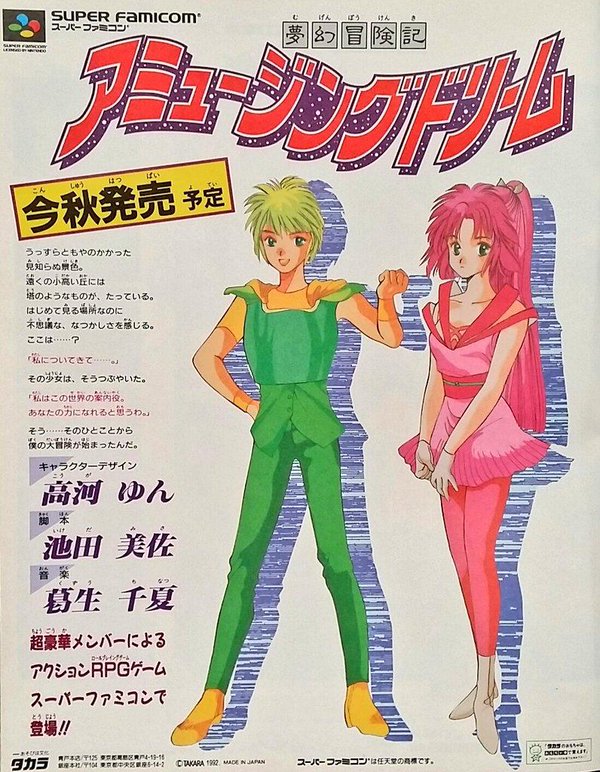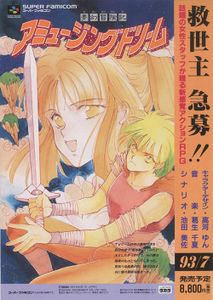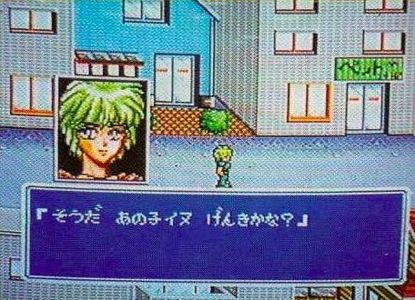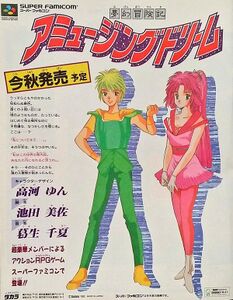Amusing Dream (lost build of cancelled Super Famicom role-playing game; 1992): Difference between revisions
m (RetroGameFan9000 moved page Mugen Boken-ki Amyujingudorimu (Cancelled 1992 Super Famicom RPG Game) to Mugen Bouken-ki Amyu-Jingudori-Mu (Cancelled 1992 Super Famicom RPG Game)) |
|||
| (45 intermediate revisions by 9 users not shown) | |||
| Line 1: | Line 1: | ||
{{ | {{InfoboxLost | ||
|title = <center> | |title=<center>Amusing Dream</center> | ||
|image = Mugen Boken-ki Amyujingudorimu.jpg | |image=Mugen Boken-ki Amyujingudorimu.jpg | ||
|imagecaption=Scan of the advertisement from a Japanese video game magazine. | |||
|imagecaption = Scan of the advertisement from a Japanese video game magazine. | |status=<span style="color:red;">'''Lost'''</span> | ||
|status = <span style="color:red;">'''Lost'''</span> | |||
}} | }} | ||
''''' | '''''Amusing Dream''''' (夢幻冒険記 アミュージングドリーム ''Mugen Bouken-ki Amyūjingu Dorīmu'', ''Dream Adventure Chronicles: Amusing Dream'') is a cancelled JRPG game for the Super Nintendo Entertainment System (SNES, published as the Super Famicom in Japan) that was developed by Takara. | ||
The game's character | The game's character design was done by mangaka Kouga Yun; the script was written by Ikeda Misa and music composed by Kuzuu Chinatsu. | ||
==Plot== | ==Plot & Japanese Adverts== | ||
The | The two earliest extant pieces of evidence are two Japanese advertisements from 1992 and 1993, which both depict the same characters two characters. They are the only descriptions we have for the plot of the game and those involved in its development. | ||
The first of the two adverts read: <blockquote>“An unknown landscape shrouded in a thin mist. On a small hill, far away, stands a tower-like figure. Though it is the first time the protagonist sees this place, it makes him feel a strange nostalgia. | |||
==Preview== | A girl appears and whispers to him ‘Follow me, I am the guide of this world. I think I can help you.’ | ||
From those few words, his adventure begins.”</blockquote>The poster additionally claims that the game was scheduled to be released that fall.<ref>[https://www.reddit.com/r/translator/comments/4t1gei/japanese_english_unreleased_sfc_game_advertisement/ Translation and discussion of the Japanese 1992 poster and video game name on Reddit.] Retrieved 5 June '23</ref> | |||
The 1993 poster states: <blockquote> | |||
“I wanted to ‘experience’ the adventure stories in the video games with my own body... By chance, this dream became a reality. My adventure began with a girl in a strange landscape."</blockquote>Unlike the 1992 advert, the Japanese 1993 poster slates the game’s release as July that year. Both adverts feature the same two characters: a green-haired boy, who is likely the protagonist, and a pink-haired girl with long hair. Unfortunately, the ads do not provide any other details beyond their character art, such as their names.<ref>[https://www.reddit.com/r/translator/comments/141kys5/japanese_english_super_famicom_advertisement_for/?utm_source=share&utm_medium=ios_app&utm_name=iossmf&utm_content=2&utm_term=15 Translation of the Japanese 1993 poster by Reddit user r/fushigitubo.] Retrieved 5 June '23</ref> | |||
==French Preview== | |||
In 2010 monokuma on unseen64.net posted about the game, sharing a digital scan of ''SuperPower''. ''SuperPower''—a French gaming magazine published and circulated from 1991 to 1994 under different names—released a preview of the game, saying:<blockquote>“''Amusing Dream'' is a truly Japanese RPG, with truly Japanese characters and truly Japanese graphic design. But is all of this Japanese, you may wonder? Absolutely, and consequently, we are very doubtful whether Japan-exclusive 'Amusing Dream' will ever be distributed in Europe. This is approximately what Takara told us when we came blundering in. This Dream may be Amusing, but it will not become a reality, at least not in our country..."</blockquote>The French-based magazine provides a confusing set of information. The preview implies that the writer was in direct contact with someone from within Takara, who was making the game. Additionally, the article casts doubt on the idea that any European localizations would be made. However, they don’t explicitly disavow the idea of an American release, and even provide an English name for the game: ''Amusing Dream''. | |||
The screencap provided by the article includes a green-haired character, potentially the same one depicted in the artwork of the 1992 and 1993 advertisements.<ref>[https://www.unseen64.net/2010/02/22/mumu-boukenki-amusing-dream-snes-cancelled/ monokoma’s post on unseen64.net, which includes the French preview and 1993 advert.] Retrieved 5 June ‘23</ref> | |||
==Cancelation== | |||
There are currently no details as to how deep the game was in development when cancelled. It can be safely assumed, however, that the game was thoroughly fleshed out; multiple advertisements have been discovered, and the French version includes a screencap of the game alongside its review. | |||
There are no known game demos or releases of the game. | |||
Due to the discrepancies between the release dates of the two Japanese adverts, it can be safely assumed that production of the game required the release date to be pushed back by several months before it was dropped altogether. | |||
==Gallery== | |||
<gallery mode="packed" heights="200"> | |||
File:Mugen Boken-ki Amyujingudorimu 2.jpg|The second Japanese advertisement for the game, including slightly different information. Published in 1993. | |||
File:Mugen Boken-ki Amyujingudorimu gameplay.jpg|Preview from French magazine ''SuperPower''. | |||
File:Amusing dream screenshot.jpg|In-game dialogue: ''"I see... I wonder if that puppy is okay?"'' The character depicted may be the green-haired protagonist in the Japanese adverts. | |||
File:F4CB69E9-1154-4506-97C4-21E14514ACEA.jpeg|The first Japanese advertisement for the game from around 1992. | |||
</gallery> | |||
==References== | ==References== | ||
{{reflist}} | |||
==External Link== | |||
*[https://aucfree.com/items/j636585571 Japanese listing on aucfree.com for a print of the 1993 advertisement.] Retrieved 5 Jul ‘23 | |||
[[Category:Lost video games]] | [[Category:Lost video games]] | ||
[[Category:Completely lost media]] | |||
Latest revision as of 22:37, 7 December 2023
Amusing Dream (夢幻冒険記 アミュージングドリーム Mugen Bouken-ki Amyūjingu Dorīmu, Dream Adventure Chronicles: Amusing Dream) is a cancelled JRPG game for the Super Nintendo Entertainment System (SNES, published as the Super Famicom in Japan) that was developed by Takara.
The game's character design was done by mangaka Kouga Yun; the script was written by Ikeda Misa and music composed by Kuzuu Chinatsu.
Plot & Japanese Adverts
The two earliest extant pieces of evidence are two Japanese advertisements from 1992 and 1993, which both depict the same characters two characters. They are the only descriptions we have for the plot of the game and those involved in its development.
The first of the two adverts read:
“An unknown landscape shrouded in a thin mist. On a small hill, far away, stands a tower-like figure. Though it is the first time the protagonist sees this place, it makes him feel a strange nostalgia.
A girl appears and whispers to him ‘Follow me, I am the guide of this world. I think I can help you.’
From those few words, his adventure begins.”
The poster additionally claims that the game was scheduled to be released that fall.[1] The 1993 poster states:
“I wanted to ‘experience’ the adventure stories in the video games with my own body... By chance, this dream became a reality. My adventure began with a girl in a strange landscape."
Unlike the 1992 advert, the Japanese 1993 poster slates the game’s release as July that year. Both adverts feature the same two characters: a green-haired boy, who is likely the protagonist, and a pink-haired girl with long hair. Unfortunately, the ads do not provide any other details beyond their character art, such as their names.[2]
French Preview
In 2010 monokuma on unseen64.net posted about the game, sharing a digital scan of SuperPower. SuperPower—a French gaming magazine published and circulated from 1991 to 1994 under different names—released a preview of the game, saying:
“Amusing Dream is a truly Japanese RPG, with truly Japanese characters and truly Japanese graphic design. But is all of this Japanese, you may wonder? Absolutely, and consequently, we are very doubtful whether Japan-exclusive 'Amusing Dream' will ever be distributed in Europe. This is approximately what Takara told us when we came blundering in. This Dream may be Amusing, but it will not become a reality, at least not in our country..."
The French-based magazine provides a confusing set of information. The preview implies that the writer was in direct contact with someone from within Takara, who was making the game. Additionally, the article casts doubt on the idea that any European localizations would be made. However, they don’t explicitly disavow the idea of an American release, and even provide an English name for the game: Amusing Dream.
The screencap provided by the article includes a green-haired character, potentially the same one depicted in the artwork of the 1992 and 1993 advertisements.[3]
Cancelation
There are currently no details as to how deep the game was in development when cancelled. It can be safely assumed, however, that the game was thoroughly fleshed out; multiple advertisements have been discovered, and the French version includes a screencap of the game alongside its review.
There are no known game demos or releases of the game.
Due to the discrepancies between the release dates of the two Japanese adverts, it can be safely assumed that production of the game required the release date to be pushed back by several months before it was dropped altogether.
Gallery
References
- ↑ Translation and discussion of the Japanese 1992 poster and video game name on Reddit. Retrieved 5 June '23
- ↑ Translation of the Japanese 1993 poster by Reddit user r/fushigitubo. Retrieved 5 June '23
- ↑ monokoma’s post on unseen64.net, which includes the French preview and 1993 advert. Retrieved 5 June ‘23
External Link
- Japanese listing on aucfree.com for a print of the 1993 advertisement. Retrieved 5 Jul ‘23




